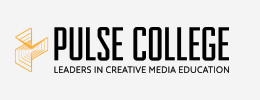BA (Hons) in Animation

Course Overview
Step into the world of Animation with our hands-on, industry-aligned course designed for aspiring Animators.
This Honours Level Degree in Animation (QQI Level 8) is taught in partnership with Pulse College, a leader in creative media education, and allows students to take their first steps toward becoming professional animators.
This course covers a full range of topics from drawing skills to 3D modelling, 3D lighting, character texturing, character animating, environmental modelling, animation rendering, and 2D animation, Comic Books and Sequential Art, Animation for Video Games. It is also designed to teach you valuable professional workflows.

Intake Dates
- Dublin - Full-Time - September 2026
Why Choose This Animation Degree?
Pulse College’s BA (Hons) Degree in Animation offers an industry-focused, professionally taught program designed to launch your career in the creative animation industry both in Ireland and internationally. Developed by working animation professionals, this hands-on course ensures you gain the technical skills, creative abilities, and industry-standard portfolio needed to succeed in this fast-growing field.
Learn from industry professionals who are actively working in the animation, games, and VFX sectors.
Gain expertise across all core areas of animation, including:
- 2D animation techniques
- 3D modelling
- Storyboarding
- Comic books and sequential art
- Build a comprehensive animation portfolio tailored for job-readiness in animation studios, gaming companies, and VFX production houses.
- Enjoy full access to the Adobe Creative Cloud—All Apps plan, which gives you 20+ professional-grade tools for digital illustration, motion graphics, video editing, and more.
- Experience a practical, hands-on curriculum that goes beyond academic theory, designed to meet and exceed current industry standards.
Develop the skills required for diverse roles such as:
- Animator
- Character designer for games
- Concept artist
- VFX animator
This program is ideal for aspiring creatives looking to gain both the artistic vision and technical proficiency to thrive in the global animation industry.
Related Courses
Course Details
Module Information
Animation History: Research and Critical Analysis
2D Animation 1
Life Drawing
Portfolio Development
3D Animation 1
Experimental Animation
Storyboarding and Layout
Concept Art
3D Animation 2
The Essence of Movement: Film and Drama
Texturing, Unwrapping and Shading
Narrative & Storytelling
Visual Culture & Theory 1
Compositing and Effects
2D Animation 2
Visual Culture & Theory 2
Rigging and Facial Animation
Business for Animation
Audio Production
Videogames Tools & Environments
Sculpting & Modelling
Dissertation/Dissertation by Practice
Law for Animation
Studio Etiquette and Professional Practice
If you have any queries regarding the course or the course information, please get in touch with Pulse directly here.
Timetables
Timetables:
The course will run roughly 15-20 hours weekly, between Monday and Friday, 9 am - 6 pm.
Exact Timetables will be made closer to the starting date
How to Apply
Entry Requirements
All applicants must also pass an assessed interview with the course director at Pulse. Once an application is submitted, we will be in contact to arrange this.
Irish citizens under 23 years of age:
Must meet the following Leaving Certificate Entry Requirements:
H5 or better in 2 subjects
O6 / H7 in 4 additional subjects, incl. mathematics and English or Irish
Or:
FETAC Level 6 / HETAC Level 7 in Music/Media or similar
Or:
A minimum of 2 Grade C A Levels as well as 4 subjects from either A levels (Grades A-E) or GCSE (Grades A,B or C). Or NVQ Level 3 in Music/Media or similar.
Irish citizens 23 years of age and older (mature students):
A student over the age of 23 years of age on 1 January of the year the course commences is classified as a Mature Student. Mature learners may apply on the basis of work experience.
International students
Entry onto the BA (Hons) Degree in Animation is based upon a course interview. International students below the age of 23 years will be required to submit High School Diploma Scripts and any additional Education Certifications. For applicants whose first language is not English, they will be asked to submit an original or certified true copy of one of the following:
IELTS - 6.0 (no component below 5.5)
DUOLINGO TEST - 105 - 115 (overall - no component below 95).
CEFRL Level - CEF B2+
GRIFFITH PLACEMENT TEST - 67 - 73 (no component lower than 60)
TOEFL (IBT) - 60 (overall - no component below 12)
CAMBRIDGE - 169 (overall no component below 162)
PEARSON - 46 (overall - no component below 36)
For more information, please visit here.
Fees
For purposes of fee calculation, residence is counted from time of application.
If you have any questions about fees, please contact Pulse College directly.
Please note that not all study modes may be offered at all times; for confirmation, refer to the Intake dates on the Overview tab.
Tuition Fees
Study Mode: Full-Time
Dublin: EUR 8,950.00
Study Mode: Full-Time
Please refer to the Irish/EU Living Abroad Fees section.
Study Mode: Full-Time
Dublin:
Non-EU living in Ireland or abroad: Please refer to our Non-EU Tuition Fees section.
Flexible payment options
Students wishing to pay their fees monthly may avail of our direct debit scheme. Please view our Fees information page for more information and assistance.
Sponsorship
Is your company paying for your course?
They will need to complete a Griffith College Sponsorship Form and send this to the Student Fees Office:
- Post: Student Fees, Griffith College Dublin, South Circular Road, Dublin 8
- Email: [email protected]
2% Learner Protection Charge
All QQI accredited programmes of education and training of 3 months or longer duration are covered by arrangements under section 65 (4) of the Qualifications and Quality Assurance (Education and Training) Act 2012 whereby, in the event of the provider ceasing to provide the programme for any reason, enrolled learners may transfer to a similar programme at another provider, or, in the event that this is not practicable, the fees most recently paid will be refunded.
QQI Award Fee
Please note that a QQI Award Fee applies in the final year of all QQI courses. To find the relevant fee for your course level, please see the Fees page.
Progression
Graduates of the BA (Hons) Degree in Animation (Level 8) have a range of exciting progression paths available:
- In line with national education policy, graduates are eligible to apply for Level 9 postgraduate programmes in animation, design, and related creative disciplines.
-
As industry tools and technologies evolve, graduates may also choose to pursue professional development courses or specialist certifications to stay at the forefront of the animation sector.
Many of our alumni have successfully progressed into careers such as:
- Animator
- Character Designer for Games
- Concept Artist
- VFX Animator
- And many other roles across the creative media and entertainment industries
Whether pursuing further education or stepping directly into the animation industry, this programme equips students with the skills and portfolio to take the next step with confidence.

